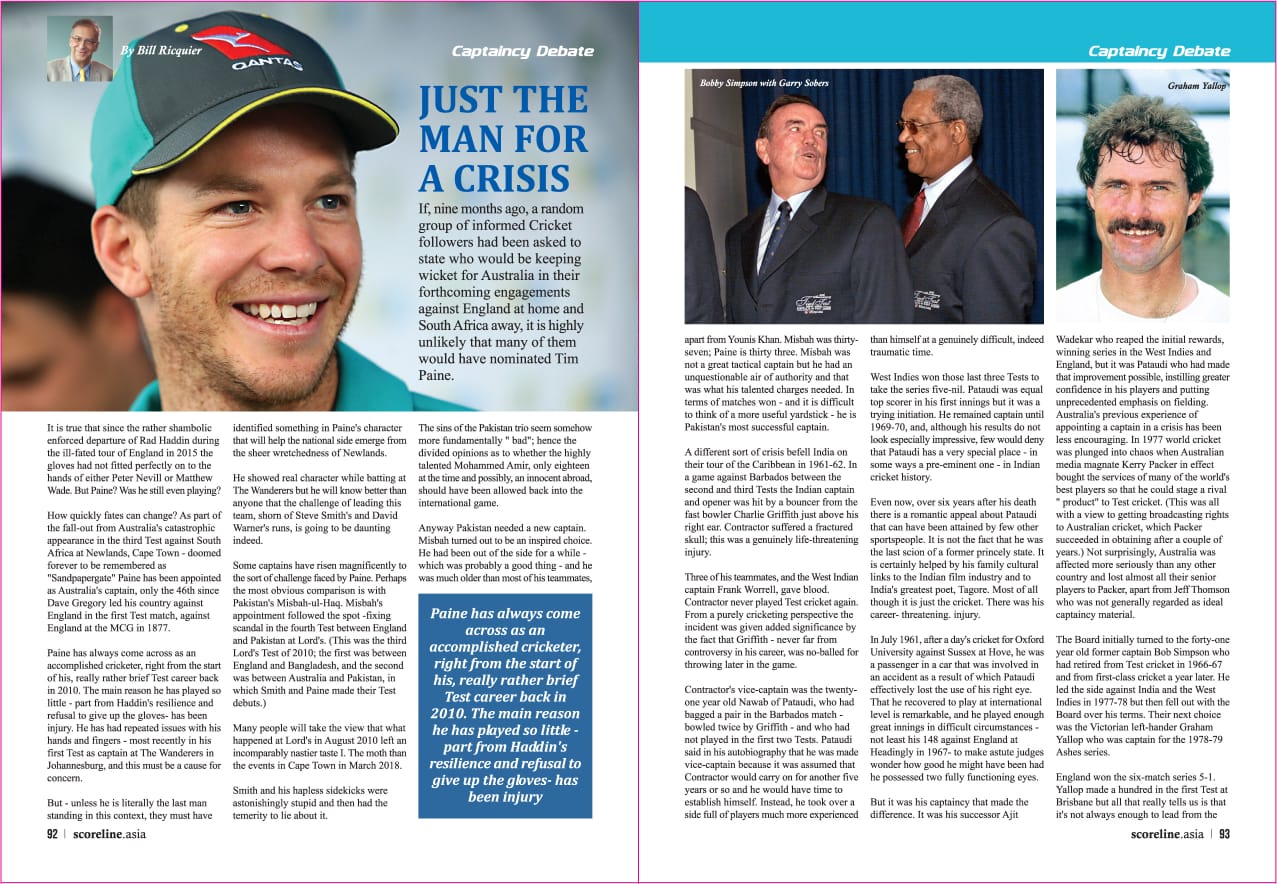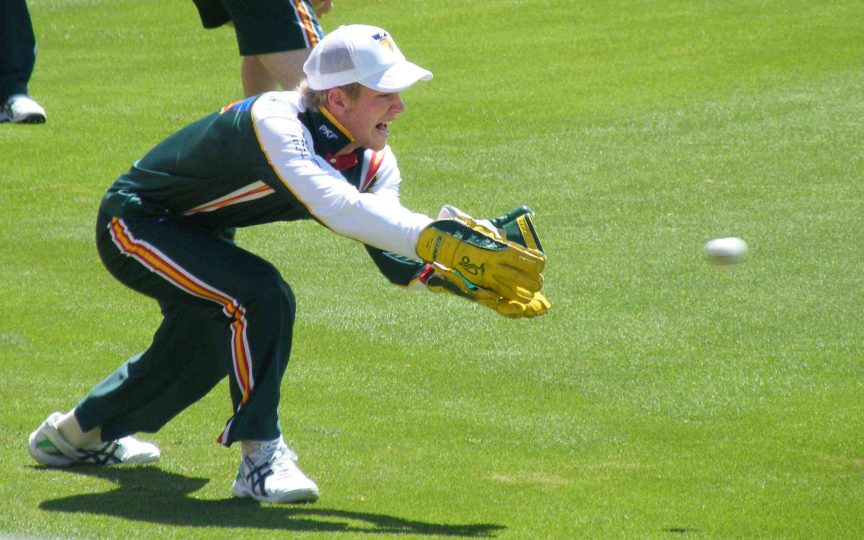If, nine months ago, a random group of informed Cricket followers had been asked to state who would be keeping wicket for Australia in their forthcoming engagements against England at home and South Africa away, it is highly unlikely that many of them would have nominated Tim Paine. It is true that since the rather shambolic enforced departure of Rad Haddin during the ill-fated tour of England in 2015 the gloves had not fitted perfectly on to the hands of either Peter Nevill or Matthew Wade. But Paine? Was he still even playing?
How quickly fates can change? As part of the fall-out from Australia’s catastrophic appearance in the third Test against South Africa at Newlands, Cape Town – doomed forever to be remembered as “Sandpapergate” Paine has been appointed as Australia’s captain, only the 46th since Dave Gregory led his country against England in the first Test match, against England at the MCG in 1877.
Paine has always come across as an accomplished cricketer, right from the start of his, really rather brief Test career back in 2010. The main reason he has played so little – apart from Haddin’s resilience and refusal to give up the gloves – has been injury. He has had repeated issues with his hands and fingers – most recently in his first Test as captain at The Wanderers in Johannesburg, and this must be a cause for concern. But – unless he is literally the last man standing in this context, they must have identified something in Paine’s character that will help the national side emerge from the sheer wretchedness of Newlands. He showed real character while batting at The Wanderers but he will know better than anyone that the challenge of leading this team, shorn of Steve Smith’s and David Warner’s runs, is going to be daunting indeed.
Some captains have risen magnificently to the sort of challenge faced by Paine. Perhaps the most obvious comparison is with Pakistan’s Misbah-ul-Haq. Misbah’s appointment followed the spot -fixing scandal in the fourth Test between England and Pakistan at Lord’s. (This was the third Lord’s Test of 2010; the first was between England and Bangladesh, and the second was between Australia and Pakistan, in which Smith and Paine made their Test debuts.)
Many people will take the view that what happened at Lord’s in August 2010 left an incomparably nastier taste in the mouth than the events in Cape Town in March 2018.. Smith and his hapless sidekicks were astonishingly stupid and then had the temerity to lie about it. The sins of the Pakistan trio seem somehow more fundamentally “bad”; hence the divided opinions as to whether the highly talented Mohammed Amir, only eighteen at the time and possibly, an innocent abroad, should have been allowed back into the international game.
Anyway Pakistan needed a new captain. Misbah turned out to be an inspired choice. He had been out of the side for a while – which was probably a good thing – and he was much older than most of his teammates, apart from Younis Khan. Misbah was thirty-seven; Paine is thirty three. Misbah was not a great tactical captain but he had an unquestionable air of authority and that was what his talented charges needed. In terms of matches won – and it is difficult to think of a more useful yardstick – he is Pakistan’s most successful captain.
A different sort of crisis befell India on their tour of the Caribbean in 1961-62. In a game against Barbados between the second and third Tests the Indian captain and opener was hit by a bouncer from the fast bowler Charlie Griffith just above his right ear. Contractor suffered a fractured skull; this was a genuinely life-threatening injury. Three of his teammates, and the West Indian captain Frank Worrell, gave blood. Contractor never played Test cricket again. From a purely cricketing perspective the incident was given added significance by the fact that Griffith – never far from controversy in his career, was no-balled for throwing later in the game.
Contractor’s vice-captain was the twenty-one year old Nawab of Pataudi, who had bagged a pair in the Barbados match – bowled twice by Griffith – and who had not played in the first two Tests. Pataudi said in his autobiography that he was made vice-captain because it was assumed that Contractor would carry on for another five years or so and he would have time to establish himself. Instead, he took over a side full of players much more experienced than himself at a genuinely difficult, indeed traumatic time.
West Indies won those last three Tests to take the series five-nil. Pataudi was equal top scorer in his first innings but it was a trying initiation. He remained captain until 1969-70, and, although his results do not look especially impressive, few would deny that Pataudi has a very special place – in some ways a pre-eminent one – in Indian cricket history.
Even now, over six years after his death there is a romantic appeal about Pataudi that can have been attained by few other sportspeople. It is not the fact that he was the last scion of a former princely state. It is certainly helped by his family cultural links to the Indian film industry and to India’s greatest poet, Tagore. Most of all though it is just the cricket. There was his career- threatening. injury. In July 1961, after a day’s cricket for Oxford University against Sussex at Hove, he was a passenger in a car that was involved in an accident as a result of which Pataudi effectively lost the use of his right eye. That he recovered to play at international level is remarkable, and he played enough great innings in difficult circumstances – not least his 148 against England at Headingley in 1967- to make astute judges wonder how good he might have been had he possessed two fully functioning eyes.
But it was his captaincy that made the difference. It was his successor Ajit Wadekar who reaped the initial rewards, winning series in the West Indies and England, but it was Pataudi who had made that improvement possible, instilling greater confidence in his players and putting unprecedented emphasis on fielding.
Australia’s previous experience of appointing a captain in a crisis has been less encouraging. In 1977 world cricket was plunged into chaos when Australian media magnate Kerry Packer in effect bought the services of many of the world’s best players so that he could stage a rival ” product” to Test cricket. (This was all with a view to getting broadcasting rights to Australian cricket, which Packer succeeded in obtaining after a couple of years.) Not surprisingly, Australia was affected more seriously than any other country and lost almost all their senior players to Packer, apart from Jeff Thomsin who was not generally regarded as ideal captaincy material.
The Board initially turned to the forty-one year old former captain Bob Simpson who had retired from Test cricket in 1966-67 and from first-class cricket a year later. He led the side against India and the West Indies in 1977-78 but then fell out with the Board over his terms. Their next choice was the Victorian left-hander Graham Yallop who was captain for the 1978-79 Ashes series. England won the six-match series five-one. Yallop made a hundred in the first Test at Brisbane but all that really tells us is that it’s not always enough to lead from the front. He failed to inspire his players and had a fraught relationship with the pa e bowler Rod ey Hogg, who took forty one wickets in the series. Yallop led Australia in their next Test, against Pakistan in March 1979 at the MCG. Pakistan secured their second victory in Australia in sensational fashion. On the final morning Australia needs seventy seven to win with seven wickets in hand but Sarfraz Nawaz cleaned up all seven for one run. That was it as far as Yallop’s captaincy was concerned. He was injured and would have missed the next game but Kim Hughes was put in charge for that game and stayed there – not that he was a great improvement. Yallop struggled to secure his place where the Packer players returned, but he was a good player, especially against spin. He scored 268 against Pakistan at the MCG in 1983-84.
England’s experience during the Packer years was rather different. The impact of the schism was scarcely less immense. The captain, Tony Greig, was Packer’s chief lieutenant. But the perfect replacement was available. The Middlesex captain, Mike Brearley was in the process of establishing himself in the side when Greig was removed from the captaincy. He was a fine batsman at county level but never did himself justice in Test matches. As a captain though, he was exceptional and remains one of the few Test captains who could justify a place in the side solely by virtue of his leadership skills. Tactical acumen was one thing. It was his ability to communicate, motivate and irritate that stood out. Hogg famously put it best: “He’s got a degree in people”.
For Paine, there is not just the fact that he is stepping into this vital job at a time of crisis for Australian cricket. There is also the fact that he is the wicketkeeper. This ought not to be an issue but the fact is that there have not been many wicketkeepers who have been great Test captains. Australia have only had one “official” captain who led in eight Tests. (Oddly enough, in the first Ashes Test I went to, at Headingley in 1968, both captains, Colin Cowdrey and Bill Lawry, were injured; Australia were led by their keeper, Barry Jarman.)
On the whole keepers have not made great captains. This is odd in a way. A smart keeper must by definition be an astute reader of the game and the role that many of them adopt of chivvying the fielders along requires certain skills that would not be inappropriate in a leadership role. That said, not every keeper seems as perceptive as one might assume in the often critical issue of DRS calls, where the keeper is bound to play a vital role.
But wicketkeeper captains have tended to be fairly underwhelming. Alec Stewart was worthy but unexceptional as a captain. Gerry Alexander is really only remembered, as a captain, for being the last white leader of the West Indies. Brendon McCullum sensibly gave the gloves to B-J Watling. Lee Germon… oh yes. The exception has been India’s Mahendra Singh Dhoni. His record in all formats and in many if not all conditions is genuinely remarkable. Occasionally Test cricket seemed slightly to disenchant him, as on the tour of England in 2014. But he was the first captain to take India to the TOP of the unofficial Test rankings (in 2009) and they won the World Cup, the Champions Trophy and the World T20 Cup under him as well. He was a thoroughly proficient keeper, a fine Test batsman, and as a finisher in limited-overs cricket, in the same league as the previously incomparable Michael Bevan.
If Paine could even approach some of that, most people would think it was a job well done.
Bill Ricquier
Feature image of Tim Paine from 2008 by Naparazzi [CC BY-SA 2.0], via Wikimedia Commons

Published in Scoreline.asia as “Just the Man for a Crisis”
Share this Post
